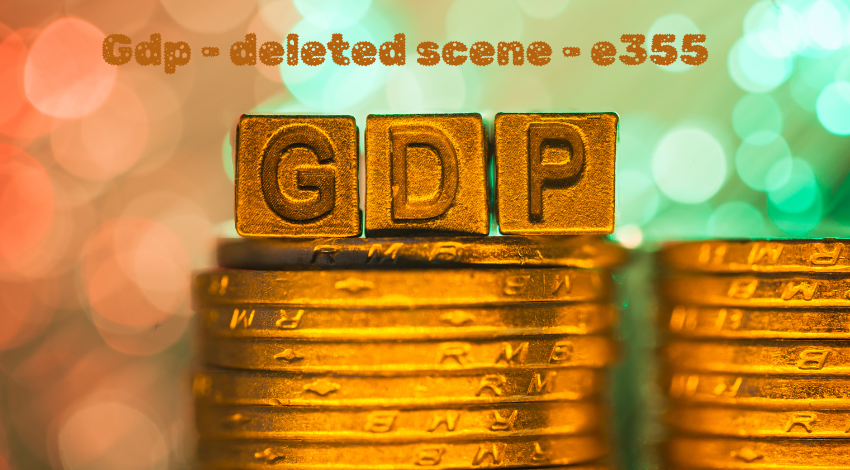Introduction to GDP – Deleted Scene – E355
Ever wondered about the hidden stories behind economic data? Welcome to “GDP – Deleted Scene – E355 Unveiled.” In this blog post, we will explore the often-overlooked aspects of Gross Domestic Product (GDP) that can provide deeper insights. Whether you’re a financial data analyst or an economic enthusiast, understanding these hidden facets can be a game-changer. Expect to learn about the various components of GDP, how they affect economic performance, and why the “deleted scenes” can reveal more than the main script.
What is GDP?
Gross Domestic Product (GDP) gdp – deleted scene – e355 is a critical measure of a nation’s economic performance. It represents the total market value of all goods and services produced within a country during a specific period. For financial analysts and economists, GDP gdp – deleted scene – e355 serves as a primary indicator of economic health. However, the term “GDP – Deleted Scene – E355” suggests there are hidden or overlooked aspects within this measure that merit exploration.
GDP gdp – deleted scene – e355 is often broken down into components such as consumption, investment, government spending, and net exports. These components provide a comprehensive view of economic activity. However, not all relevant data is always included in official GDP gdp – deleted scene – e355 calculations. The “deleted scenes” refer to the data and nuances that might be left out, offering a broader perspective on economic performance. Understanding these omitted details is essential for a holistic view of the economy.
The concept of “GDP – Deleted Scene – E355” prompts us to consider what might be missing from traditional GDP gdp – deleted scene – e355 analysis. It encourages us to look beyond the surface and dig deeper into the economic data that shapes our understanding of financial markets. By doing so, we can gain a more accurate and nuanced view of economic conditions.
Why Focus on Deleted Scenes?
The term “Deleted Scene – E355” suggests a specific aspect or chapter within the larger narrative of GDP. It hints at a hidden layer of economic data that demands attention. To comprehend this fully, we must explore what might be concealed within this “deleted scene.” This could involve examining data points that are not typically included in official GDP gdp – deleted scene – e355 reports but have a significant impact on economic performance.
For example, the “E355” could refer to an economic variable or dataset that is often overlooked. This might include factors such as income inequality, regional disparities, or the economic contributions of marginalized communities. By shining a light on these hidden elements, we can gain a more comprehensive understanding of economic well-being and develop more effective policies to address disparities.
The significance of “GDP – Deleted Scene – E355” lies in its potential to reshape our understanding of economic data. It challenges us to question conventional measures and consider the broader context in which economic activities occur. By doing so, we can develop more accurate and inclusive assessments of economic performance.
The Hidden Layers of Economic Data
Economic data is multi-faceted and complex. When calculating GDP, certain elements may be excluded or underestimated. These “deleted scenes” can significantly impact our understanding of economic performance. Traditional GDP gdp – deleted scene – e355 calculations might not account for informal economic activities, underground markets, or unrecorded transactions. These hidden layers of economic data can paint a different picture of economic health.
For instance, consider the informal economy, which includes unregulated and untaxed activities. In many developing countries, the informal sector plays a substantial role in economic activity. However, traditional GDP calculations often exclude these contributions. By exploring the “deleted scenes” of GDP, we can better understand the true scale of economic activity and its impact on society.
Another overlooked aspect is environmental degradation. Traditional GDP gdp – deleted scene – e355 measures economic output without considering the environmental costs associated with production. The “GDP – Deleted Scene – E355” concept encourages us to factor in these hidden costs, leading to a more sustainable and accurate assessment of economic performance.
The Core Components of GDP
To fully appreciate the “deleted scenes,” it’s essential to understand the core components of GDP first. These include consumer spending, government spending, investments, and net exports. Each of these elements plays a vital role in shaping the overall economic landscape. For example, consumer spending often accounts for the largest portion of GDP gdp – deleted scene – e355, reflecting the purchasing power and confidence of households. Government spending, on the other hand, can indicate public investment in infrastructure and services.
Consumer Spending
Consumer spending is a significant driver of GDP gdp – deleted scene – e355 and often reflects the economic well-being of a country’s residents. High consumer spending usually indicates a robust economy, while low spending can signal economic distress. Factors influencing consumer spending include disposable income, consumer confidence, and interest rates. By analyzing these factors, you can gain insights into the health of the economy and predict future economic trends.
Government Spending
Government spending is another critical component of GDP gdp – deleted scene – e355 and includes expenditures on public services, infrastructure, and social programs. This type of spending can stimulate economic growth by creating jobs and boosting demand for goods and services. However, excessive government spending can lead to budget deficits and increased national debt, which may have long-term economic consequences. Understanding the balance between these factors is crucial for evaluating the sustainability of economic policies.
Investments
Investments, both public and private, are essential for economic growth. They include spending on infrastructure, machinery, technology, and education. High levels of investment can lead to increased productivity and economic expansion. However, poor investment decisions can result in wasted resources and economic stagnation. By examining investment trends, you can identify emerging opportunities and potential risks in the economic landscape.
Net Exports
Net exports, calculated as the difference between a country’s exports and imports, also contribute to GDP. A positive net export figure indicates a trade surplus, while a negative figure suggests a trade deficit. Trade balances can be influenced by factors such as exchange rates, global demand, and trade policies. Understanding these dynamics can help you assess a country’s economic competitiveness and its position in the global market.
The Role of Informal Economy
One of the most intriguing “deleted scenes” in GDP analysis is the informal economy. This includes unregistered businesses, black-market activities, and under-the-table employment. While these activities are not captured in official GDP statistics, they can significantly impact the economic landscape. For instance, in many developing countries, the informal economy accounts for a substantial portion of total economic activity. Ignoring this aspect can lead to an incomplete understanding of economic health.
The Role of Technology in Unearthing Hidden Data
Advancements in technology have revolutionized the way we collect and analyze economic data. Big data analytics, machine learning, and artificial intelligence have enabled us to uncover hidden patterns and trends that were previously inaccessible. These technological tools can help us identify and analyze the “deleted scenes” within GDP data, providing a more comprehensive view of economic performance.
For instance, data analytics can track informal economic activities that are not captured in traditional GDP calculations. By analyzing transaction data, social media trends, and other digital footprints, we can estimate the scale and impact of these hidden economic activities. This information can be invaluable for policymakers and economists seeking to develop more accurate and inclusive economic models.
Furthermore, technology can help us assess the environmental impact of economic activities. Satellite imagery, remote sensing, and environmental monitoring systems can provide data on deforestation, pollution, and resource depletion. By incorporating this data into GDP calculations, we can develop more sustainable economic indicators that account for the true costs of production.
Regional GDP Variations
Another often-overlooked aspect is regional GDP variations within a country. Different regions may experience varying levels of economic growth due to factors such as resource distribution, industrial development, and government policies. Analyzing regional GDP can reveal disparities and highlight areas that require targeted economic interventions. This granular approach can provide a more nuanced understanding of a country’s economic performance.
Sectoral Contributions
Sectoral contributions to GDP also offer valuable insights. Different sectors, such as agriculture, manufacturing, and services, contribute differently to GDP. For example, in many advanced economies, the services sector accounts for the largest share of GDP, reflecting a shift from manufacturing-based economies. By examining sectoral contributions, you can identify the driving forces behind economic growth and potential areas for diversification.
The Impact of Technological Advancements
Technological advancements play a crucial role in shaping economic performance. Innovations in technology can boost productivity, create new industries, and transform existing ones. For example, the rise of the digital economy has led to the emergence of tech giants and the decline of traditional brick-and-mortar businesses. Understanding the impact of technology on GDP can help you anticipate future economic trends and investment opportunities.
External Factors Influencing GDP
External factors, such as global economic conditions, geopolitical events, and natural disasters, can also impact GDP. For instance, a global recession can lead to reduced demand for a country’s exports, while geopolitical tensions can disrupt trade routes and supply chains. By monitoring these external factors, you can better understand their potential impact on economic performance and make informed decisions.
Policy Implications of GDP Analysis
Understanding the subtler aspects of GDP can also have significant policy implications. Policymakers can use this information to design targeted economic interventions, such as stimulus packages, tax incentives, and regulatory reforms. By addressing the underlying factors affecting GDP, policymakers can promote sustainable economic growth and improve overall economic well-being.
Conclusion
In conclusion, the “deleted scenes” of GDP offer a treasure trove of insights that can enhance your understanding of economic performance. By exploring these hidden facets, you can gain a more comprehensive view of the economy and make more informed decisions. Whether you’re a financial data analyst, an economic enthusiast, or a policymaker, understanding these nuances can provide a competitive edge. To learn more about these fascinating aspects of GDP, consider subscribing to our newsletter or joining our upcoming webinar.












